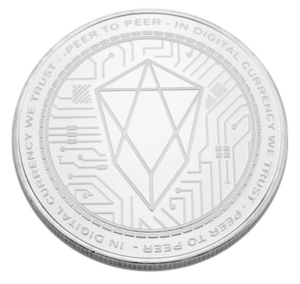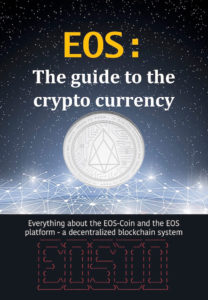EOS – what is this? EOS is a crypto currency that wants to reinvent the blockchain platforms, and this book presents them in detail.
EOS crypto currency: the book on the blockchain platform
While blockchain technologies such as Bitcoin can no longer develop properly, EOS is starting with a new technical foundation for blockchains: the Delegated Proof of Stake, a new consensus protocol.
This consensus protocol outsources the processing of blocks to the delegates. This allows EOS to process a large number of transactions and run many applications.

At the same time, EOS also benefits from its user-friendly design and the ability to run distributed applications (dApps). What can the dApps do on EOS? What is the potential of this platform? This book presents the crypto currency in detail.
What exactly is EOS?
EOS is a project that focuses on the crypto currency Ethereum and wants to improve its weaknesses. Just like Ethereum, EOS is a crypto currency with blockchain technology for the development of decentralized applications (DApps). It facilitates the development of dapps by providing a set of OS-like services and functions that dapps can use.
The idea behind EOS is to bring together the best features and promises of the various existing smart contract technologies (e.g. Bitcoin security, Ethereum IT support) into an easy-to-use and massively scalable application platform for everyday users to increase blockchain adoption. Unlike Ethereum, EOS is based on a proof-of-stake algorithm that eliminates the horrendous energy consumption. In addition, EOS is structured differently to Ethereum in some details.
There are some important technical developments, such as distribution of consensus to 21 “delegates”, high scalability, no transaction fees for end users, possibility to change codes for smart contracts, and “accounts” as an abstraction layer between the “wallet” and the end user, making the application much more user-friendly.
What questions does the book on the EOS Coin answer?
I would like to answer the following questions in this book:
- What exactly is EOS?
- How does EOS work?
- How can you buy EOS and where can you keep it?
- What can EOS be used for?
- How can you develop EOS applications yourself?
- How will EOS evolve?
Advantages of EOS as a crypto currency
- Provision of infrastructure: EOS provides a complete platform that developers can access.
- Scalability: it enables a large number of transactions per second.
- Proof of stake instead of proof-of-work:
- Low-latency communication (response times): EOS applications achieve higher throughput rates than Ethereum, for example, due to a different architecture.
- Decentralization: there is no central server or owner.
- Free of charge: Transactions are free for end users,
- Modularity: Other technologies can dock to EOS.
- Source openness: The program code can be retrieved on the Internet.
- User security: EOS uses ‘accounts’ that allow multiple transactions. Hacked accounts can be restored.
- Governance: the so-called block producers can vote on events in the EOS network, such as code changes.
- Transactions can be executed offline
- interoperability
If these benefits have made you curious, click on the BIld to learn more about the EOS book. The book has 120 pages and is available for $4.99 (eBook) or $9.99 (paperback):
